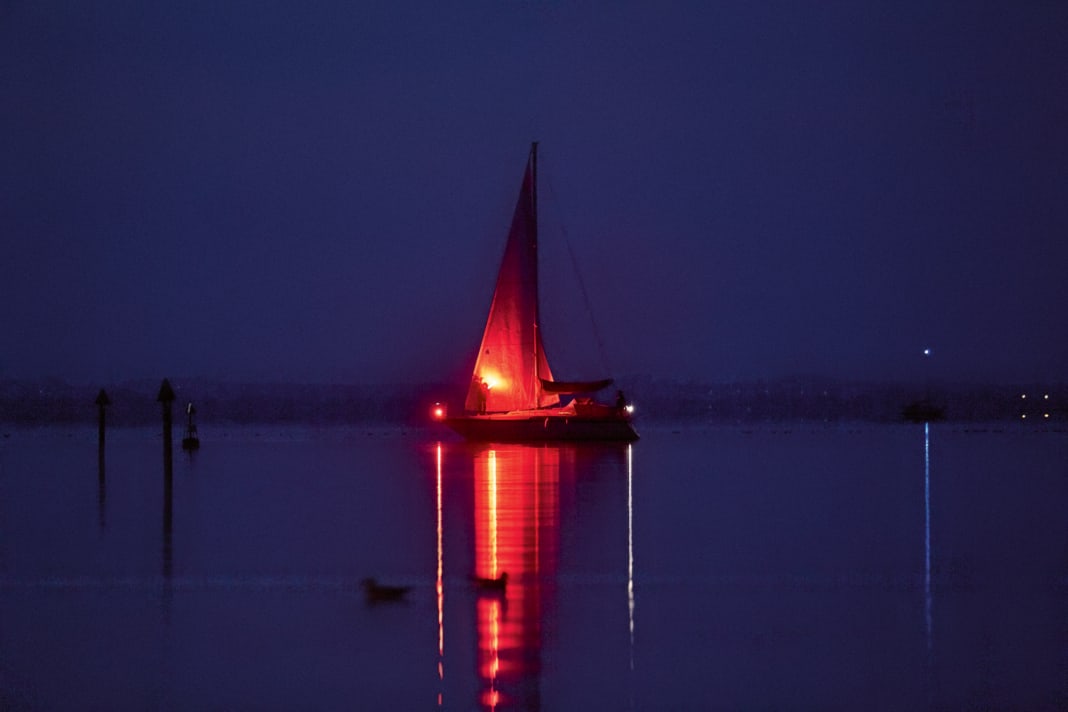





Emergency situations are difficult to predict and are synonymous with stress. It is important to keep a cool head, especially in critical moments, in order to get the situation under control or at least not make it any worse.
An important point here is practice. If you have already played through the situation in your head and in practice, you are more likely to be able to make the right decisions than someone who is thrown in at the deep end unprepared. This applies to manoeuvre sequences, but also to the emergency as such.
Also interesting:
You should make a plan for calling for help in particular, as there are a surprising number of options for requesting assistance in an emergency at sea. The best option depends on the boat's equipment and the situation.
"Pressing the distress button on the DSC radio or a call on VHF channel 16 is still the best way to ensure that the emergency call reaches us directly. In the event of a DSC alarm, the position is transmitted immediately and in the event of an emergency call via channel 16, the position can be located," says Ralf Baur from the German Maritime Search and Rescue Service (DGzRS). Another advantage of raising the alarm by radio is that a Mayday or Panpan call on channel 16 is international, meaning that the nearest emergency control centre within range will respond. This means that there is no need to search for country-specific emergency numbers.
Flow chart for radio messages in VHF marine radio
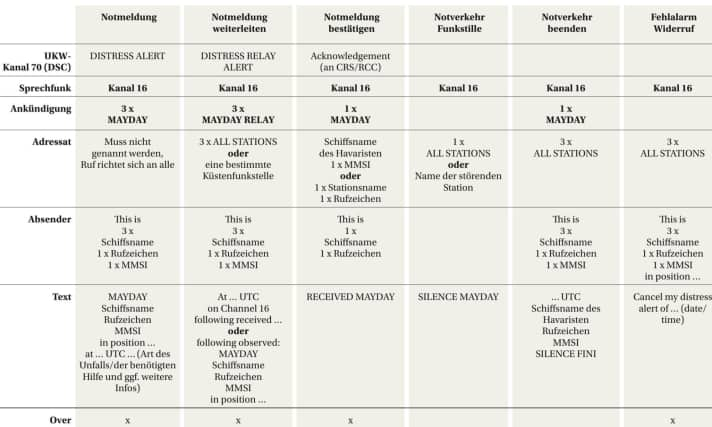
In Europe, this also applies to calling the emergency number 112, but then you don't end up directly at the control centre responsible for maritime emergencies, but at a general emergency call centre. This can lead to delays and misunderstandings, as the operators on duty cannot immediately conclude that there is an emergency at sea if the information is unclear. The DGzRS Maritime Rescue Coordination Centre also uses the AML system. This stands for Advanced Mobile Location and enables mobile phones to be located throughout the EU without the user having to do anything. The devices automatically activate the location services and send their GPS position to the control centre via SMS or the Internet. This is particularly important if the crew member making the emergency call does not know the exact location of the yacht or is unable to provide clear information in a stressful situation.
If you call the speed dial 124 124 from any German mobile network without an area code, you can reach the sea rescuers directly and the DGzRS can retrieve the position data from the mobile phone. Although 124 124 is not an official emergency number and can only be reached from German mobile phone networks and only near the coast, the position is transmitted and it is not only possible to locate the mobile phone via the radio cell. The rescue control centre at sea requests the data from the same server as the control centres on land. The route and technology are identical. The query is usually carried out automatically in the background by the operations control system in the control centres.
Keep escape routes short.
In order to keep rescue routes short, the local emergency services should be informed by radio or by dialling 112 when abroad. Emergency traffic will then be handled in English. If you are still looking for the landline numbers of the control centres, you can find them on www.sarcontacts.info.
Emergency calls via satellite
IPhones from the 14th generation onwards and the Google Pixel 9 can make emergency calls via satellite connection even without mobile phone coverage. However, these are text messages. A voice connection is not possible. Samsung currently only offers the service on the American market. Ralf Baur from the DGzRS explains: "When calling 124 124 with an iPhone, the call or text is sent directly to the maritime rescue control centre via the routing of a call centre if the position is in the German maritime search and rescue area. This has not been tested with Android phones and may not have been set up on the phones."
Fully automatic emergency calls can be made via EPIRB. These emergency radio beacons offer worldwide coverage and are intended for ships or life rafts. They transmit the distress message with position information via satellite to the rescue coordination centre. They therefore always trigger a rescue operation that is coordinated from shore. As a smaller version for the lifejacket, the emergency radio beacons are called Personal Locator Beacons or PLBs. Both work with the Cospas-Sarsat system. In contrast to VHF radio, nearby ships cannot be alerted, only the rescue coordination centre is informed. Ships that could help are only contacted by the MRCC in the second step and only receive the coordinates of the accident site in this way. However, it is possible to send a so-called Enhanced Group Call (EGC) via satellite systems (Inmarsat and Iridium). This is then received by all equipped ships in a defined sea area.
All satellite transmitters must be registered. In Germany, registration takes place at the Federal Network Agency. The MMSI issued there must be programmed into the emergency transmitter by the dealer. Personalised registration is not possible in Germany; if you want to use a PLB on a charter ship, for example, you can try to register the transmitter in England.
With certain restrictions, a distress call can also be made via AIS-MOB. However, AIS MOBs are not part of the global maritime distress and safety radio system GMDSS. Although their activation triggers various alarms, it does not necessarily trigger a rescue operation. According to the DGzRS, AIS MOBs and SARTs are used for localisation after a distress call has been made. As the range of MOBs and SARTs is very limited, it cannot necessarily be assumed that the signal can always be located
If you want to ensure this, you should use a device with an additional DSC function that can work in an open loop. This means that an emergency message is sent to all radio stations after the AIS alarm. This is also received by the rescue coordination centre and must be confirmed by them. DGzRS man Ralf Baur: "It should also be noted here that due to the antenna heights, it is not guaranteed that the DSC will reach the MRCC. This depends on the distance to the nearest receiving antennas on land. Ships in the vicinity that receive the distress of the open-loop can pass it on with their DSC device. As far as we know, a closed loop is transmitted before the open loop, which only goes to the own ship. If this is not confirmed, the open loop is triggered for everyone.
Since this year, only devices that can also receive the confirmation may transmit in the open loop. Class M AIS MOBs fulfil this requirement. Problem with the AIS MOB: The rescue services assume that someone has fallen overboard and have no way of contacting the crew directly.
Pyrotechnic distress signals should also be on board, as they can also be used to alert outsiders. Compared to radio transmitters, however, they have a limited range. The DGzRS would like to point out that pyrotechnic signalling devices should not be fired on suspicion and on the off chance, but if possible at the request of the rescuers (if the position is unclear and/or the destination is unclear), or if a vehicle in the vicinity could see the signal. The use of pyrotechnic signalling devices on good luck should be a last resort, as there are usually only a few pyrotechnic signalling devices on board.
Emergency call or call for help?
In an emergency at sea, a distinction is made between an emergency call and an urgent call. An emergency call is appropriate if there is an acute danger to life and limb. For example, if a crew member goes overboard, the yacht is in danger of sinking or a fire has broken out on board. The distress call is initiated by radio with MAYDAY, see page 70. If only the engine has failed or the boat has run aground in good weather so that no human life is in danger, but assistance is still required, this is referred to as an emergency call or PANPAN. Distress signals should only be used for this if no other alarm option such as radio or telephone is available.
VHF radio
Emergency call via DSC radio
![DEU;DE;GERMANY;DEUTSCHLAND;ALLEMAGNE, Kiel, Scleswig-Holstein. 11.3.2008 VHF radios under test: Ultra shortwave, DSC, DSC controller [ (c) Klaus Andrews, Pferdeweide 1, D-22589 Hamburg, Germany, Tel. +49-40-870 840 01, Mobil 0171 / 413 31 20, www.KlausAndrews.com, mail@KlausAndrews.com, account no. 1268491444, BLZ 200 505 50, HASPA. IBAN: DE59 2005 0550 1268 4914 44 BIC HASPDEHHXX, www.freelens.com/clearing, Any use only against payment of a fee, copyright notice and receipt; if the photo is used for purposes other than journalism, please contact the photographer. No modelrelease! ][#0,121#]](https://media.delius-klasing.de/dk-wassersport/images/dpr_auto,fl_progressive,f_auto,c_fill,h_475,w_712/q_auto:eco/yacht/100150893_5cc664cc6b3aa427f3530eadcecf6506/deu-de-germany-deutschland-allemagne-kiel-scleswig-holstein-11-3-2008-vhf-radios-under-test-ultra-shortwave-dsc-dsc-controller-c-klaus-andrews-pferdeweide-1-d-22589-hamburg-germany-tel-49-40-870-840-01-mobil-0171-413-31-20-www-klausandrews-com-mail-klausandrews-com-account-no-1268491444-blz-200-505-50-haspa-iban-de59-2005-0550-1268-4914-44-bic-haspdehhxx-www-freelens-com-clearing-any-use-only-against-payment-of-a-fee-copyright-notice-and-receipt-if-the-photo-is-used-for-purposes-other-than-journalism-please-contact-the-photographer-no-modelrelease-0-121-)
If the distress button is pressed for longer than three seconds, the device triggers an emergency call and, if available, also transmits the GPS position. The call is sent to all radio stations and also alerts the distress centre if one of its relay stations is within range, which - depending on the antenna height - is the case up to around 30 nautical miles off the coast.
Channel 16
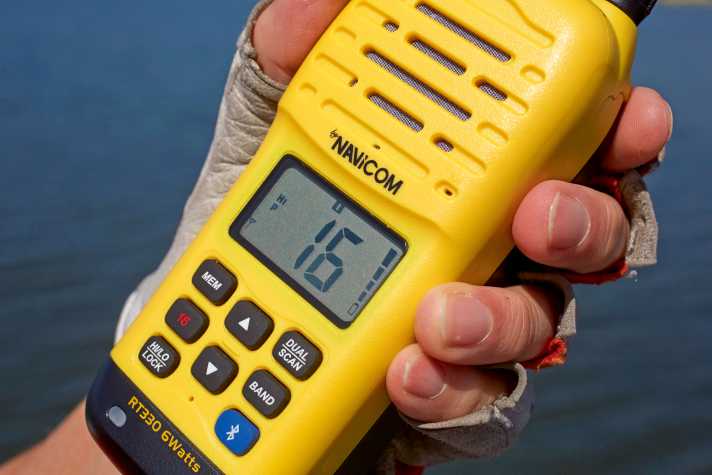
If you do not have a DSC device on board, you can make an emergency call on channel 16. The type of emergency is localised with the signal words "Mayday" or "Panpan" (see above). Handheld radios have a limited range. However, as many people are listening in on channel 16, there is still a good chance that the emergency call will be picked up and passed on as a mayday relay.
Telephone
Without net
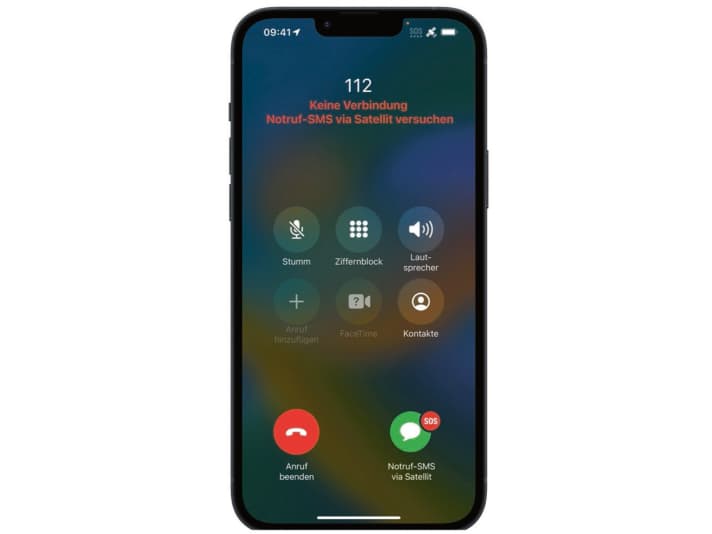
Smartphones such as the iPhone from the 14th generation or the Pixel 9 can make an emergency call even without mobile phone coverage. Only emergency numbers such as 112 can be dialled via the satellite connection and only text messages can be sent.
Via app
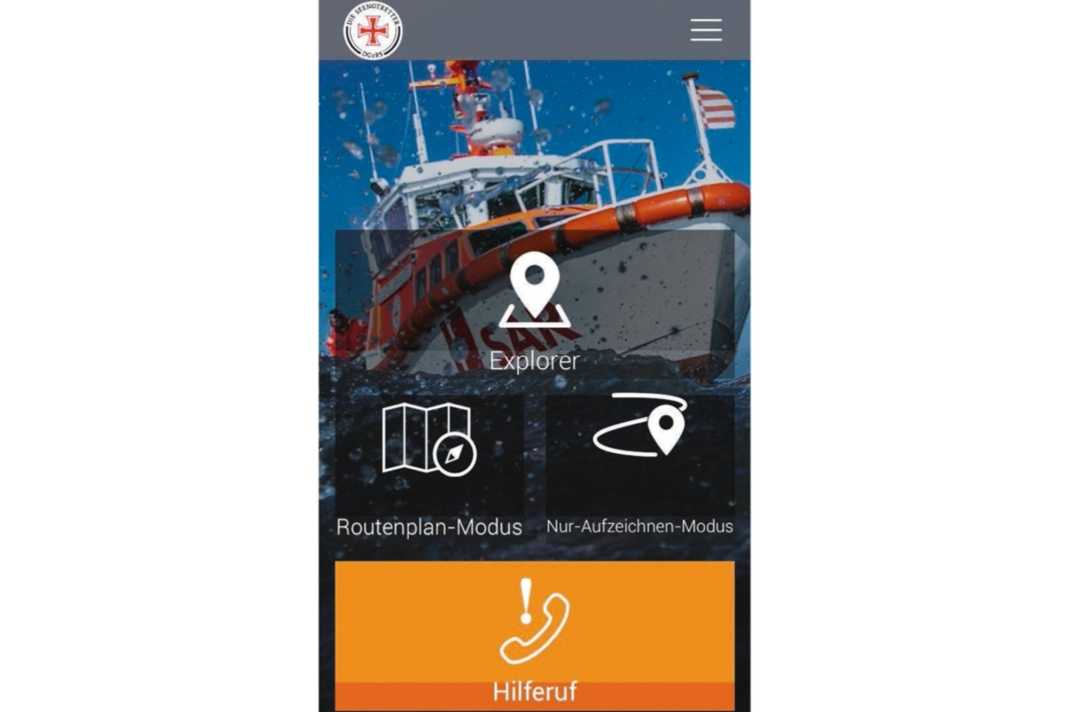



The free SafeTRX app from the German Maritime Search and Rescue Service (DGzRS) can be used to make emergency and help calls, whereby the app establishes a telephone connection to the rescue coordination centre in Bremen. The highlight: the app also transmits the current or last known position of the smartphone. In addition, the user can enter the planned arrival time before departure and allow the journey to be plotted. If the arrival time is exceeded, the stored emergency contact is notified, who can ask the app user whether there is an emergency and release the track for the rescuers so that they know in which area to search. With the waterproof Safetrx Active emergency bracelet, the app functions can also be used independently of the mobile phone. The bracelet costs around 270 euros, comes with an LTE-M SIM card and requires a subscription. In Germany, the contract costs 13 euros per month.
Radio beacons
AIS-MOB
![DEU;DE;GERMANY;GERMANY;ALLEMAGNE, Schleswig-Holstein, Flensburg Fjord, Geltinger Bay. 23.7.2017 Test of rescue equipment. MOB. Man overboard. Person overboard. Rescue of a sailor who has fallen overboard. Equipment used: Automatic lifejacket, AIS transponder, rescue loop with connecting line to the sailing yacht.
[ (c) Klaus Andrews, Carlshöhe 21, D-24340 Eckernförde, Germany, phone +49-4351-88 99 665, mobile +49 (0)171 - 413 31 20, www.KlausAndrews.com, mail@KlausAndrews.com, account no. 1268491444, sort code 200 505 50, HASPA. IBAN: DE59 2005 0550 1268 4914 44 BIC HASPDEHHXX, www.freelens.com/clearing, Any use only against payment of a fee, copyright notice and receipt; if the photo is used for purposes other than journalism, please contact the photographer. No modelrelease! ][#0,121#]](https://media.delius-klasing.de/dk-wassersport/images/dpr_auto,fl_progressive,f_auto,c_fill,h_475,w_712/q_auto:eco/yacht/100147952_bd2d7cd3bfc4782af13d1f7f0be82261/deu-de-germany-germany-allemagne-schleswig-holstein-flensburg-fjord-geltinger-bay-23-7-2017-test-of-rescue-equipment-mob-man-overboard-person-overboard-rescue-of-a-sailor-who-has-fallen-overboard-equipment-used-automatic-lifejacket-ais-transponder-rescue-loop-with-connecting-line-to-the-sailing-yacht-c-klaus-andrews-carlshoehe-21-d-24340-eckernfoerde-germany-phone-49-4351-88-99-665-mobile-49-0-171-413-31-20-www-klausandrews-com-mail-klausandrews-com-account-no-1268491444-sort-code-200-505-50-haspa-iban-de59-2005-0550-1268-4914-44-bic-haspdehhxx-www-freelens-com-clearing-any-use-only-against-payment-of-a-fee-copyright-notice-and-receipt-if-the-photo-is-used-for-purposes-other-than-journalism-please-contact-the-photographer-no-modelrelease-0-121-)
Emergency transmitters with an AIS signal (Automatic Identification System) are ideal for alerting your own yacht equipped with an AIS receiver if someone goes overboard. Class M devices with DSC function are recommended. They trigger an emergency call in the open loop, which is also received by the distress centres. In addition, all yachts and ships within range are alerted by DSC radio, which significantly increases the chance of a prompt rescue.
EPIRB
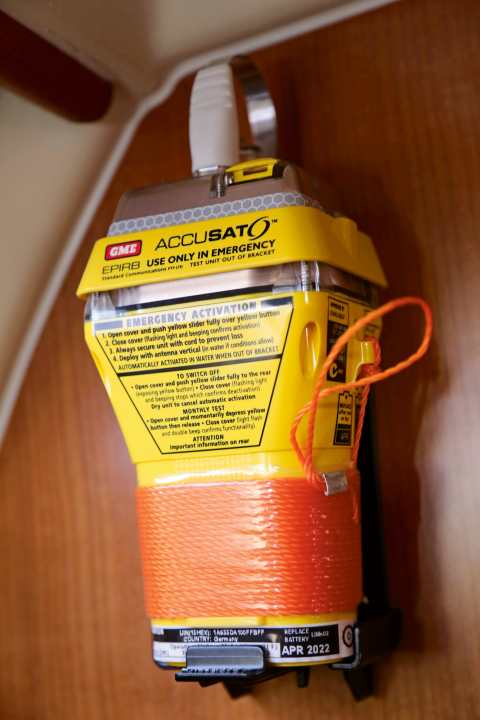
The buoyant emergency beacon is registered on the ship and triggers the rescue chain worldwide. It is impractical as a direct MOB alarm; however, the crew remaining on board can activate it to call for help.
PLB
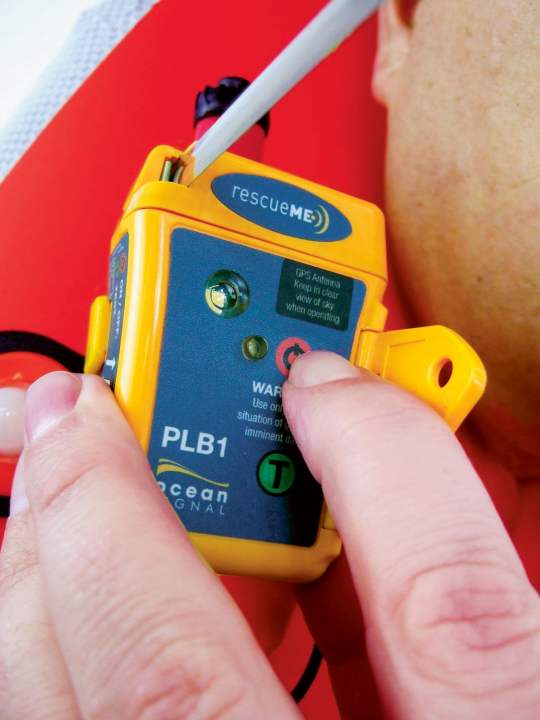
Personal Locator Beacons are barely larger than an AIS MOB and also fit into a lifejacket, but usually have to be triggered manually. It is not possible to locate them directly from your own vessel or from nearby vessels.
Satellite messenger
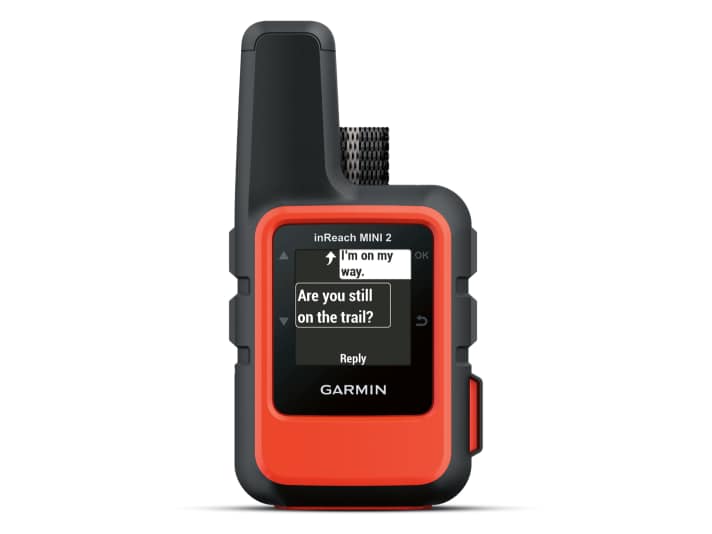
With InReach from Garmin, emergency calls can be made without the need for an MMSI. However, the alerts are not sent directly to the sea rescue service and subscription costs are incurred.
PLB with confirmation
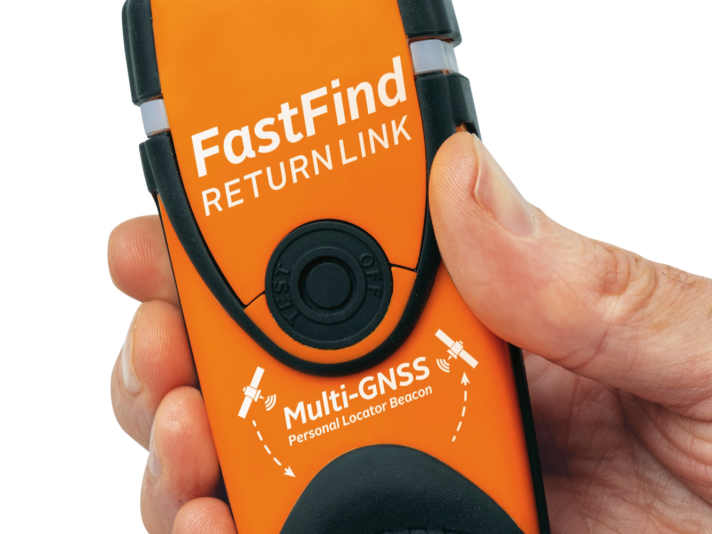
The latest generation of PLBs can be configured via an app and supports the return link function. This provides information when the emergency call has arrived at the control centre and has been acknowledged. In Germany, PLBs can only be registered on the ship and are classed as EPIRBs.
Light signals
Red signal flare
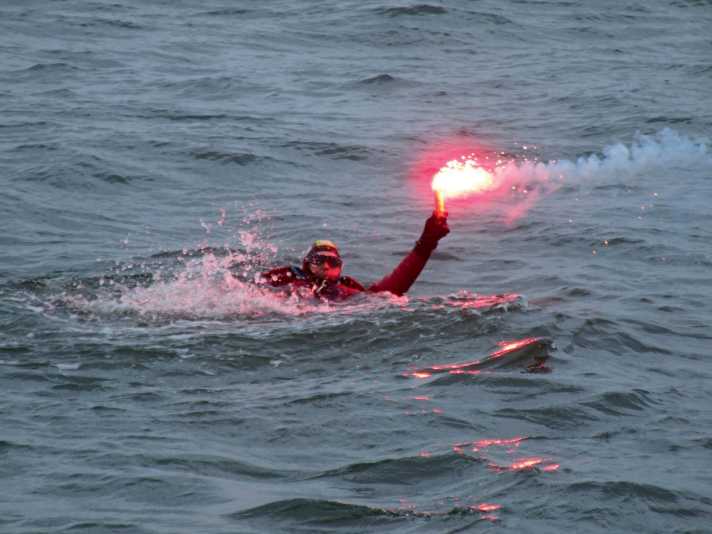
Once ignited, they provide a very bright light and can be recognised over relatively long distances. As the burning time is only between 40 and 60 seconds, they are only useful if there is someone nearby who can see the signal, for example another yacht or a helicopter. They are less suitable for initial alerting. A certificate of competence is required.
Smoking pot
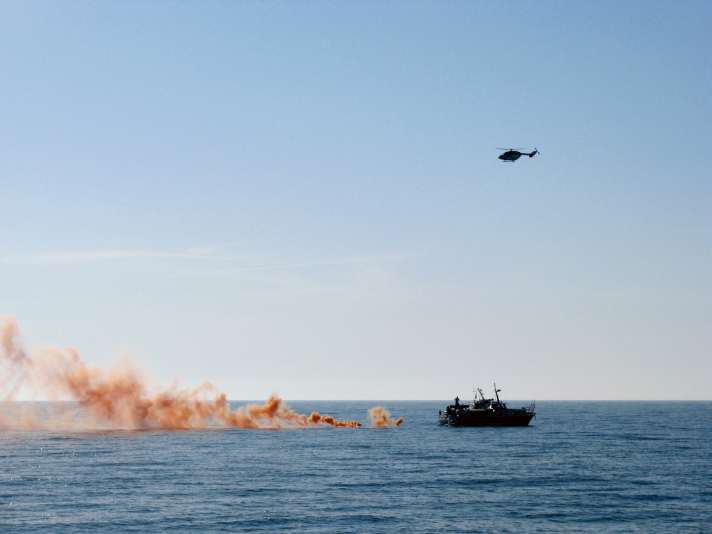
The orange smoke is only very noticeable during the day and is primarily intended to mark a distress at sea. The signals float and smoke for between three and four minutes. In contrast to hand flares, there is no risk of fire. As a side effect, the smoke helps approaching helicopter crews to assess the wind direction.
Flags and hand signals
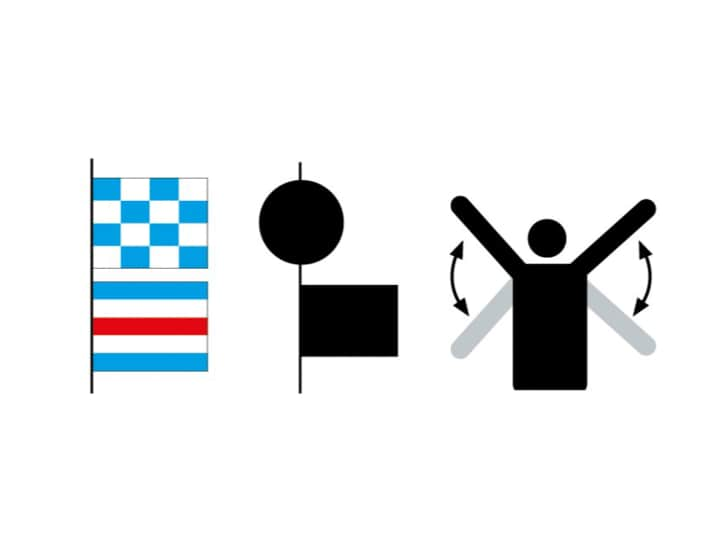
The combination of the signal flags N over C indicates a distress at sea, as does the setting of a ball and a flag in any order. However, these signals hardly play a role in practice on yachts, especially as they can only be recognised at close range. The same applies to the slow raising and lowering of both arms. However, this can be used to draw attention to an emergency in the dinghy or on a dinghy if no other means of signalling is available.
Signal pistol, distress rockets
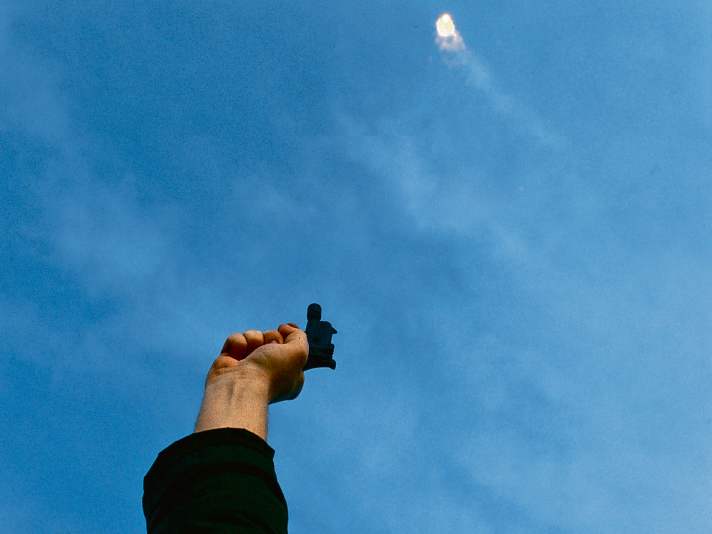
Signal pistols are hardly used any more, as it is difficult to store them on board in accordance with regulations. In addition, the cartridges have a very short burning time. Red parachute rockets are more powerful and are not considered weapons. Their signals rise to a height of around 300 metres and produce a very bright ball of light, making them visible over long distances, especially at night. They burn for 40 seconds. A certificate of competence is required.
LED signals
![DEU;DE;GERMANY;GERMANY;ALLEMAGNE, Schleswig-Holstein, Flensburg Fjord, Geltinger Bay. 21.7.2017 Test of rescue equipment. MOB. Man overboard. Person overboard. Rescue of a sailor who has fallen overboard. Devices used: Electronic LED hand torches and lasers with a slit-shaped light beam. Various manufacturers. From left to right: OceanSignal RescueMe EDF1, ODEO Flare LED, GREATLAND Rescue-Laser Flare, GREATLAND Rescue-Laser-Light. [ (c) Klaus Andrews, Carlshöhe 21, D-24340 Eckernförde, Germany, Tel. +49-4351-88 99 665, Mobil +49 (0)171 - 413 31 20, www.KlausAndrews.com, mail@KlausAndrews.com, Account no. 1268491444, BLZ 200 505 50, HASPA. IBAN: DE59 2005 0550 1268 4914 44 BIC HASPDEHHXX, www.freelens.com/clearing, Any use only against payment of a fee, copyright notice and receipt; if the photo is used for purposes other than journalism, please contact the photographer. No modelrelease! ][#0,121#]](https://media.delius-klasing.de/dk-wassersport/images/dpr_auto,fl_progressive,f_auto,c_fill,h_720,w_540/q_auto:eco/yacht/100150895_56c8148f64d698907a92c6cd9ed587c5/deu-de-germany-germany-allemagne-schleswig-holstein-flensburg-fjord-geltinger-bay-21-7-2017-test-of-rescue-equipment-mob-man-overboard-person-overboard-rescue-of-a-sailor-who-has-fallen-overboard-devices-used-electronic-led-hand-torches-and-lasers-with-a-slit-shaped-light-beam-various-manufacturers-from-left-to-right-oceansignal-rescueme-edf1-odeo-flare-led-greatland-rescue-laser-flare-greatland-rescue-laser-light-c-klaus-andrews-carlshoehe-21-d-24340-eckernfoerde-germany-tel-49-4351-88-99-665-mobil-49-0-171-413-31-20-www-klausandrews-com-mail-klausandrews-com-account-no-1268491444-blz-200-505-50-haspa-iban-de59-2005-0550-1268-4914-44-bic-haspdehhxx-www-freelens-com-clearing-any-use-only-against-payment-of-a-fee-copyright-notice-and-receipt-if-the-photo-is-used-for-purposes-other-than-journalism-please-contact-the-photographer-no-modelrelease-0-121-)
The electronic version of the signal flare is not approved as an official distress signal, but this does not matter for private users. The devices are equipped with a series of very bright LEDs and can light up continuously or flash. The light is nowhere near as bright as that of a pyrotechnic flare, but there is no smoke or heat. The biggest advantage of LED flares is their extremely long runtime. Instead of just a few seconds, they work for up to six hours and can also be switched on and off at any time. Models such as the Odeo Flare or the RescueMe EDF1 FLARE cost around 170 euros.

